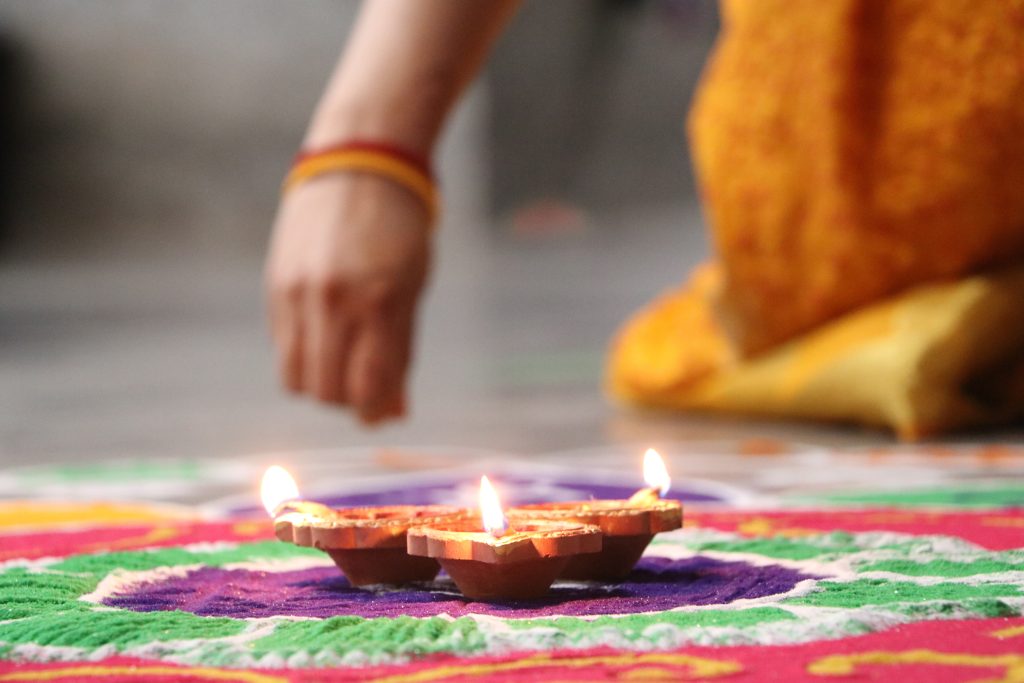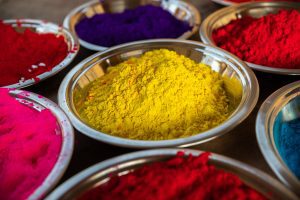- 833-265-6771
- [email protected]
- Mon - Fri: 8:00 - 5:00 EST

Imagine a burst of colors that forms an exquisite pattern, reflecting heritage, culture, and tradition. That’s Rangoli! This vibrant form of art has its roots in the rich tapestry of Indian tradition, adding charm and spiritual significance to the country’s numerous festivals and celebrations.
Rangoli, derived from the Sanskrit words “rang” and “aavalli,” translates to a row of colors. It is an artistic expression created on the floor or ground using colored powder, dry flour, colored rice, or even flower petals. These vivid patterns, often symmetrical, instill a sense of warm welcome and auspiciousness.
Rangoli is much more than mere decorative artwork. It’s a medium to express devotion and create positive energy. Predominantly seen during Indian festivals like Diwali, Pongal, Onam, and Navaratri, these intricate designs are meant to welcome the deities and bring good fortune.
Rangoli designs are incredibly varied and distinctive. From geometric patterns, deities, and floral designs to representations of mythical beings, the creative potential is limitless.
Depending upon the region, the art form may have different names. Yet they all serve the universal purpose of bringing prosperity and warding off evil.
Peeling back the layers of history, Rangoli’s roots trace back to the ancient Indian text of the Chitralakshana, the earliest Indian literature describing painting. Ancient traditions often used this art form as a symbol of wealth and prosperity, as well as a sign of hospitality.
Rangoli holds a mirror to the cultural diversity of India, with distinct styles and traditions associated with different regions. For instance, in South India, daily kolams welcome sunrise, while Alpana in Bengal graces religious ceremonies and weddings.
The historical significance of Rangoli is profound. It is not just an art form but a living tradition that strengthens communal ties, often engaging entire neighborhoods in its creation during festivals.

Creating a vibrant Rangoli might seem like a challenging task, but with the right set of materials, the process becomes more manageable and enjoyable. Here’s a list of essentials you’ll need for your Rangoli art:
Color Powders: As the primary medium for creating Rangoli, color powders (or Rangoli powders) bring your designs to life. These powders come in an assortment of hues.
Chalk or Pencil: Before you start with the color powders, it’s wise to draft your design using chalk or pencil. This helps you visualize your pattern and provides a guide when you start filling in with color. It serves as a roadmap for your artistry, ensuring that the final output aligns with your initial vision.
Dots and Grids: Dots and grids may not seem essential, but they play a crucial role in maintaining symmetry in your designs. They serve as the skeleton of your artwork, enabling you to maintain proportions and balance in intricate designs.
Trays and Funnels (Chakpu): Trays are your holding bay for color powder, while funnels or “chakpu” guide your hand in making intricate designs. These tools facilitate the smooth transition of powder from the tray to the design, reducing spillage and helping maintain precision.
Stencils (optional): For beginners or those looking to save time, stencils can be quite helpful. They provide ready-made patterns that you can simply fill in with color powder.
Selecting the Perfect Surface for Your Rangoli
The surface where you create your Rangoli is just as important as the materials you use. It can significantly impact the final look of your design. A smooth, flat, and clean surface is ideal for making Rangoli. Marble, granite, or even well-leveled ground can serve as excellent canvases for your artwork.
Before starting, ensure the surface is clean and dry, as a damp or dirty surface can cause the color powder to clump or spread unevenly.
The beauty of Rangoli art is that it can be made anywhere—from the privacy of your home to a public space during community celebrations. The most popular locations for creating Rangoli are at the entrance of the house or in courtyards, symbolizing a warm welcome to visitors and deities.
In public spaces, Rangoli can be seen at temple entrances or during community events and festivals. Always remember, the goal is to invite positivity and vibrancy, so choose a place that best suits this purpose.
Color powders are the lifeblood of Rangoli art. The eye-catching hues give Rangoli its distinctive vibrancy and charm. Traditionally, natural color powders were derived from sand, rice, turmeric, and various flower petals. But in modern times, color powders like the ones available at Color Powder Supply have become a popular choice due to their bright and varied color palette.
When using color powder, the technique is crucial. Start by outlining the pattern with chalk or a pencil. Fill the design by pinching the powder between your thumb and index finger, then slowly releasing it along the sketch lines. A funnel or “chakpu” can be used for intricate designs.
One tip for creating a spectacular Rangoli design is to always start from the center and work outwards. Also, remember to fill the colors from the inside of the design, moving outwards. This approach helps to prevent any smudging of colors.
Rangoli art, with its riot of colors and intricate patterns, is a captivating spectacle that is deeply embedded in Indian culture. Whether it’s to celebrate a festival, mark an auspicious occasion, or simply to decorate a space, creating a Rangoli is a spiritual experience that brings joy, positivity, and a sense of unity.
So the next time you come across a beautiful Rangoli, remember that it is not just a mere decoration but a vibrant testament to a tradition that has been passed down through generations.